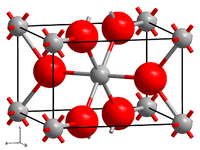Tungsten (IV) oxide
| Crystal structure | |||||||||||||||||||
|---|---|---|---|---|---|---|---|---|---|---|---|---|---|---|---|---|---|---|---|

|
|||||||||||||||||||
| __ W 4+ __ O 2− | |||||||||||||||||||
| General | |||||||||||||||||||
| Surname | Tungsten (IV) oxide | ||||||||||||||||||
| other names |
Tungsten dioxide |
||||||||||||||||||
| Ratio formula | WHERE 2 | ||||||||||||||||||
| Brief description |
brown or bronze colored |
||||||||||||||||||
| External identifiers / databases | |||||||||||||||||||
|
|||||||||||||||||||
| properties | |||||||||||||||||||
| Molar mass | 215.84 g mol −1 | ||||||||||||||||||
| Physical state |
firmly |
||||||||||||||||||
| density |
10.72 g cm −3 (25 ° C) |
||||||||||||||||||
| Melting point |
1500-1600 ° C |
||||||||||||||||||
| boiling point |
1730 ° C |
||||||||||||||||||
| solubility |
practically insoluble in water |
||||||||||||||||||
| safety instructions | |||||||||||||||||||
|
|||||||||||||||||||
| As far as possible and customary, SI units are used. Unless otherwise noted, the data given apply to standard conditions . | |||||||||||||||||||
Tungsten (IV) oxide is a chemical compound from the group of metal oxides .
Extraction and presentation
Tungsten (IV) oxide can be prepared by reduction of tungsten (VI) oxide with tungsten or hydrogen or by reaction of tungsten with water vapor obtained in each case at high temperatures.
Single crystals of the oxide can be produced using a CVT (Chemical Vapor Transport) method . For this purpose, tungsten (VI) oxide is first converted into polycrystalline oxide with elemental tungsten with the addition of a few mg of iodine in a melted and evacuated ampoule at 1100 ° C. The golden-brown oxide is then melted into a new ampoule with about 1% iodine and this is placed in a 2-zone oven so that half of the ampoule is in one of the zones. While one half of the ampoule is heated to 1000 ° C, the other half is kept at 960 ° C. After a reaction time of 3 days (with 0.5 g of oxide initially used), the ampoule is allowed to cool and, after opening, golden single crystals of the target compound about 2 mm in size are obtained.
properties
Depending on the degree of distribution, tungsten (IV) oxide is a brown (powder) to bronze-colored (single crystals) diamagnetic and metallically conductive compound. It has a monoclinic crystal structure similar to that of rutile .
use
Tungsten oxides such as tungsten (IV) oxide are components of catalysts for the petrochemical industry and for the selective catalytic reduction of nitrogen oxides with NH 3 in combustion exhaust gases from power plants . They are still used in glasses , glazes and ceramics .
Web links
- Patent.de: Process for the production of tungsten oxide layers and use
Individual evidence
- ↑ a b c Georg Brauer (Ed.) U. a .: Handbook of Preparative Inorganic Chemistry. 3rd, revised edition. Volume III, Ferdinand Enke, Stuttgart 1981, ISBN 3-432-87823-0 , p. 1564.
- ↑ a b c d e f Entry on tungsten (IV) oxide in the GESTIS substance database of the IFA , accessed on February 16, 2017(JavaScript required) .
- ↑ DB Rogers et al .: Single crystals of transition-metal dioxides - C. Tungsten dioxide and β-rhenium dioxide . In: FA Cotton (Ed.): Inorganic Syntheses . tape 13 . McGraw-Hill Book Company, Inc., 1972, ISBN 07-013208-9 ( defective ) , p. 135-145 (English).
- ^ Wells, AF (1984), Structural Inorganic Chemistry (5th ed.), Oxford: Clarendon Press, ISBN 0-19-855370-6

